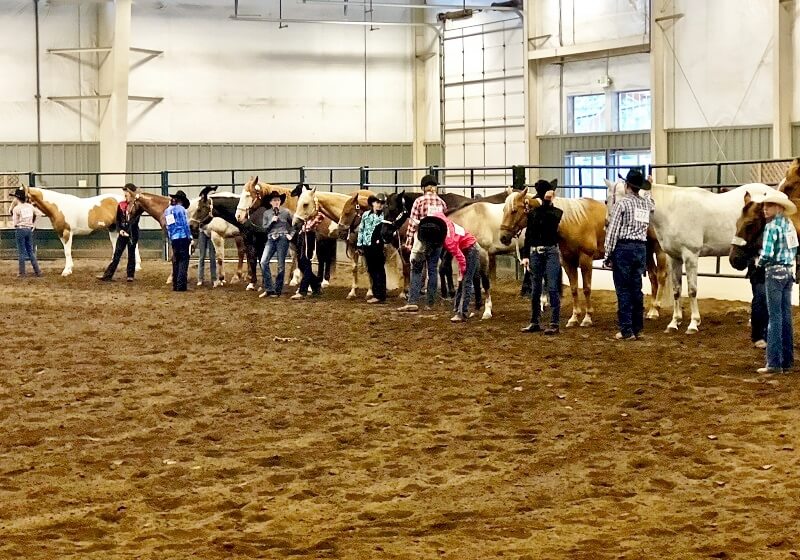Begin with Good Animal Husbandry
By: David Sauter, DVM

The 2011 National Cutting Horse Association Western National Championship wasn’t a good year in terms of a specific contagious disease: the neurologic form of Equine Herpes Virus type 1 (EHV-1). The event held in Ogden, Utah from April 29 to May 11 had over 700 entries that traveled from 19 different states and Canada. After the event, some horses went home, and others traveled on to other shows.
The first EHV-1 positive horse that was at the event in Ogden was diagnosed on May 11th in Colorado and died shortly after with EHM (Equine Herpes Myeloencephalopathy). The second was diagnosed on May 13 in Bakersfield, California and was later euthanized with EHM.
Word got out through social media before all the affected state veterinary offices were notified that there was big trouble. By the time state officials were able to track all the movements and establish quarantines, it was determined there were 421 primary exposed horses.
Primary cases were those horses that had been at the show in Ogden. Secondary horses were those that were not in Ogden but were exposed to horses that were. Tertiary horses were those that were exposed to the secondary horses. There were 1685 secondary and tertiary exposures.
In total, there were 242 premises with exposed horses. Sixty-two of these premises had positive EHV-1 cases. In the end, there were 90 cases of EHV-1, 33 of which developed EHM. A total of 13 horses died or were euthanized.
It wasn’t until June 23, 43 days after the final day at Ogden, that the USDA considered the outbreak “contained.” Over 400 horse shows in California alone were canceled. The loss of life was tragic. The time, effort, and resources to treat sick horses was tremendous. The loss of training, showing, and competing was staggering.
This scenario is a rare event but serves as a dramatic example of why biosecurity is so important. For disease to occur, there needs to be a perfect storm of three main factors that intersect: a susceptible host that is exposed to the infectious agent in an environment suitable for that agent. Biosecurity is all about exerting control over these factors.
Begin at Home
Biosecurity begins at home, well before you hit the road. Good animal husbandry is a fundamental aspect of increasing your horse’s resistance and reducing susceptibility to disease.
Provide a healthy environment with proper preventative medicine – good fencing, safe and secure barns, good ventilation, balanced nutrition, proper manure management, and regular hoof care. Regular veterinary care is included here, such as parasite control, dental work and appropriate vaccination. The emphasis is on appropriate, as the selection and timing of vaccination is important to establish effective protection against common pathogens.
At larger farms, segregate differing groups of horses. For example, keep show horses separate from the horses that stay on the farm. New arrivals should be separated from the rest for three weeks. If possible, make sure new arrivals are current on vaccinations and deworming at least two weeks prior to their arrival. New arrivals could be incubating disease without obvious symptoms.
Not only should new arrivals be segregated but so should their discharges. The new arrivals should be the last horses to be handled and to have their pens cleaned. If they are shedding a pathogen, it can literally be carried on clothing, footwear, in wheelbarrows, on hoses or on implements. Ideally use items designated for the new arrivals and dispose of their waste in a separate area.
Fever can be an early indicator of illness. Take temperatures of new arrivals twice a day and keep a written record during the three weeks of separation.
Pay attention to your own personal hygiene, including frequent hand washing, cleaning footwear, etc.
On the Road
When planning a trip or heading to a show, don’t be a Typhoid Mary. Make sure your horses are healthy before they leave. Monitor temperatures at least once a day for three days prior to leaving to help detect illness that would not otherwise be noticed.
You know your horse. If something’s off, such as appetite, stool appearance or amount, energy levels, etc., this is a red flag. Traveling could endanger your horse and cause a disease to spread to other horses.
Pay attention to what’s happening with other horses in your barn. If a cough, nasal discharge, fever or some other illness is spreading in the barn, your horse could be incubating the disease even if it has no symptoms when you hit the road. The threat is real; it might be better to stay home, for all concerned.
BYOB—bring your own bedding, buckets, implements, etc. Upon arrival, check out the stalls. Strip, clean, and disinfect before bringing your horse in. While at the show, refrain from sharing any tack or grooming supplies.
Avoid allowing nose to nose contact with other horses. Don’t dip hoses into your water buckets; there could be pathogens on the outside of the hose. Better yet, bring your own hose. Like the scenario with new arrivals, keep other horses and their discharges separate from yours. Finally, if you see something concerning, such as a coughing horse with a nasal discharge, report it to the show officials.
Biocontainment is an extension of biosecurity. It refers to containment of a disease once it has occurred. We’ll cover this subject in a separate article. Until then, enjoy your travels but don’t forget biosecurity!

Dave Sauter is a Minnesota native and graduated from the University of Minnesota in 1987. Following graduation he interned at Rood and Riddle Equine Hospital in Lexington, Kentucky. After this internship, he continued to work exclusively with horses for another five years in Kentucky before moving out West and joining Kulshan Veterinary Hospital in Lynden, WA. He is a member of the AAEP, AVMA and the WSVMA. For more information about Kulshan Veterinary Hospital call 360-354-5095 or email [email protected]. www.KulshanVet.com





